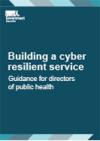Below are a few examples of the way in which a cyber attack could affect your service area and things you should consider when preventing or recovering from a cyber attack:
Figure 2: Example of service impact on public health services
During a cyber attack you may have no access to the internet or your networks within which documents are stored. You need to consider how the loss of internet access might affect your critical services, and how you could keep them running – you may need alternative manual processes in place to keep a skeleton service operational.
An example of a service level impact from a public health perspective would be that a cyber attacks would potentially compromise communication systems within healthcare organisations.
This would seriously hinder the coordination among healthcare professionals, leading to potential mismanagement of patient care, prescription errors, and almost certainly delayed responses to emergencies.
Things to consider:
- What are the critical services operated by your team rely on internet access?
- Which of these critical services are prioritised to get back online first?
- Create offline records and plans for use during an attack and ensure all teams have access to them.
Figure 3: Example of financial impact on public health services
If a cyber attack was to impact your team’s services, it could affect the financial systems that you operate. For example, your systems may experience significant operational downtime as a result of the incident. During this period, healthcare services, including appointments, treatments, and administrative processes, come to a halt. The financial losses accumulate due to the inability to deliver and bill for services.
Things to consider:
- How long will the systems be down, and what is the potential impact on critical healthcare services, patient care, and emergency response during this period?
- What revenue-generating services are affected, and how will the backlog of postponed appointments, treatments, and procedures impact revenue and workload once systems are restored?
- How will communication breakdowns and compromised services affect the public's trust, healthcare professional coordination, and the reputation of the public health system?
- What are the financial implications of operational downtime, including emergency response costs, additional communication measures, and efforts to catch up on postponed services? Are there contractual obligations that may result in financial penalties?
Figure 4: Example of data impact on public health services
The attackers have access to comprehensive medical histories, including details of illnesses, medications, and previous treatments. This sensitive health information is at risk of being misused or sold on the dark web.
The cyber attackers threaten to publicly disclose the compromised data unless a ransom is paid. This adds pressure on your team to respond quickly to prevent the exposure of public health information.
Areas to consider:
- What types of data were compromised, and how sensitive is the information? Consider both personal details and medical records to gauge the severity of the breach.
- How many individuals are affected by the data breach? Assessing the scale helps estimate the potential impact on identity theft and fraudulent activities.
- How is the organisation responding to the breach, including considerations for paying a ransom, potential public disclosure, and efforts to rebuild public trust?
- What measures are in place to prevent future breaches?
- Consider strategies for regulatory compliance, identity theft prevention, and enhancing cyber security to mitigate the risk of future attacks.

